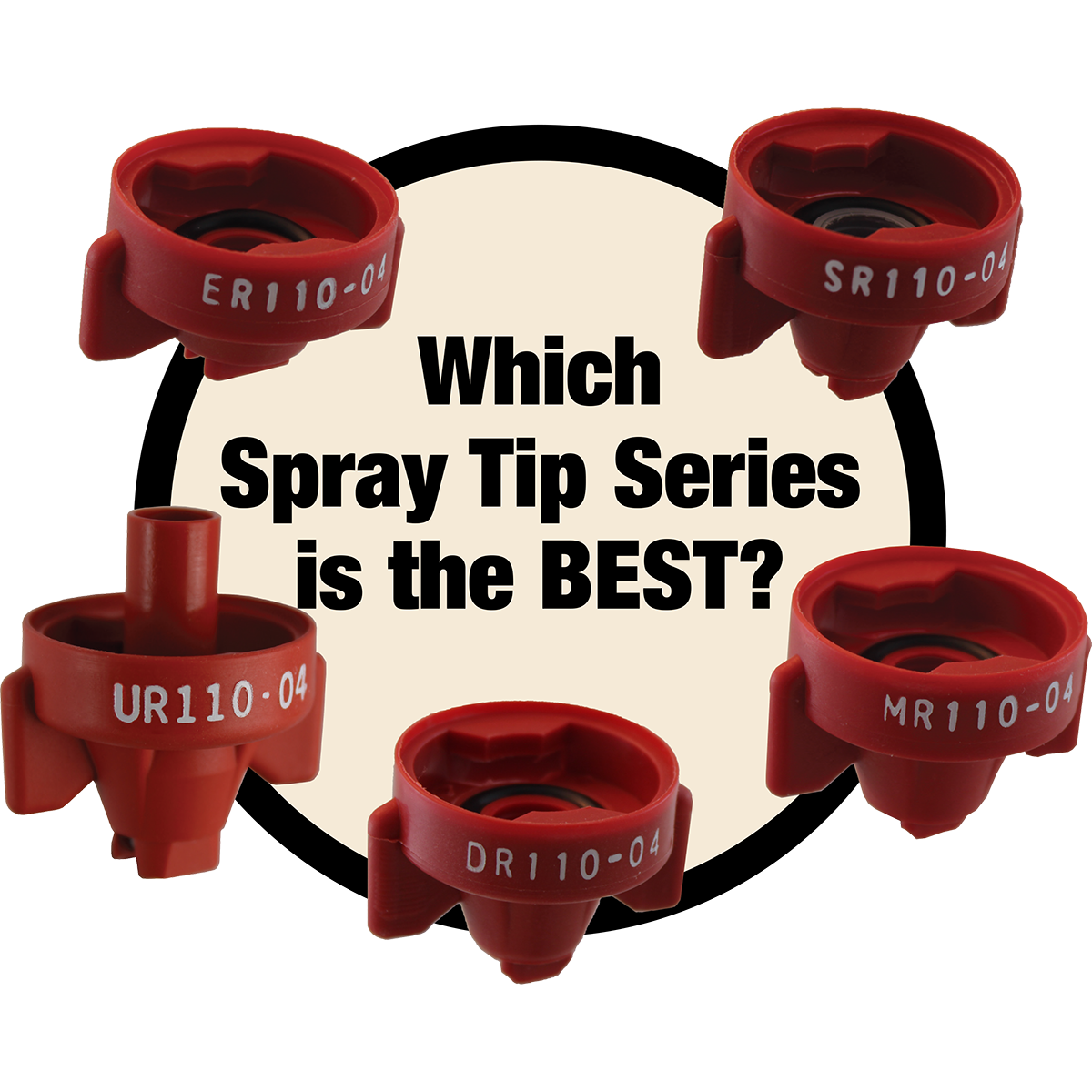
¿Cuál Serie de Pastillas es la Mejor?
El hecho de que, para cada caudal, exista la opción de una ER, SR, MR, DR y UR, puede ser confuso; lo que nos lleva a preguntarnos: «¿Cuál serie es la mejor para mí?»
Puesto que las velocidades, caudales, y requerimientos de cobertura en relación con la eficacia de aplicación varían drásticamente en lotes/cultivos/químicos diferentes, no podemos hablar de una serie que sea ‘la mejor’.
La ‘MEJOR’ pastilla es la que se adecua a sus requerimientos de velocidad y caudal, maximizando, al mismo tiempo, eficacia con el químico y el cultivo con la menor deriva fuera de destino.
Esta información ¿le parece demasiado amplia como para ayudarlo a encontrar la mejor pastilla de pulverización?
Para evitar la confusión, Wilger ofrece toda la información posible para que tome una decisión consciente; también ponemos a su disposición el Tip Wizard, una herramienta que ayudará a que tomar estas decisiones sea lo más fácil posible. Ciertamente, en conjunto con las recomendaciones del membrete y las sugerencias de su agrónomo, se puede facilitar muchísimo la selección de la mejor pastilla.
La razón por la que Wilger fabrica 5 series de pastillas diferentes para cada caudal es ofrecer al aplicador la posibilidad genuina de tener un espectro escalonado de tamaño de gotas (y caudal) que se ajuste a su ideal de aplicación de manera óptima.
Para ver un ejemplo del proceso de selección de pastillas (aplicable tanto a sistemas estándar como de Modulación por Ancho de Pulso), siga el instructivo; verá lo fácil que resulta. Sin darse cuenta, habrá encontrado la pastilla de pulverización que maximiza cobertura y minimiza deriva, aplicando -al mismo tiempo- a las velocidades que necesita aplicar.
Para aplicaciones con Sistemas de Pulverización Estándar (es decir, aplicación velocidad + presión), la capacidad de una pastilla de pulverización se define por por la habilidad de mantener cobertura máxima en presiones operativas (y velocidades) normales: Si desea utilizar el selector Tip Wizard para seguir el ejemplo, ingrese el caudal/información de entrada debajo: Aplicación ejemplar: Herbicida Sistémico para Aplicaciones de Quema. Se buscaría (basados en la información de membrete) una aplicación gruesa, o de un DVM aprox. de 400µ.

El selector Tip Wizard arroja los siguientes resultados: DR110-015, DR110-02, MR110-02, DR110-025, MR110-025[…]
Análisis de la DR110-015:
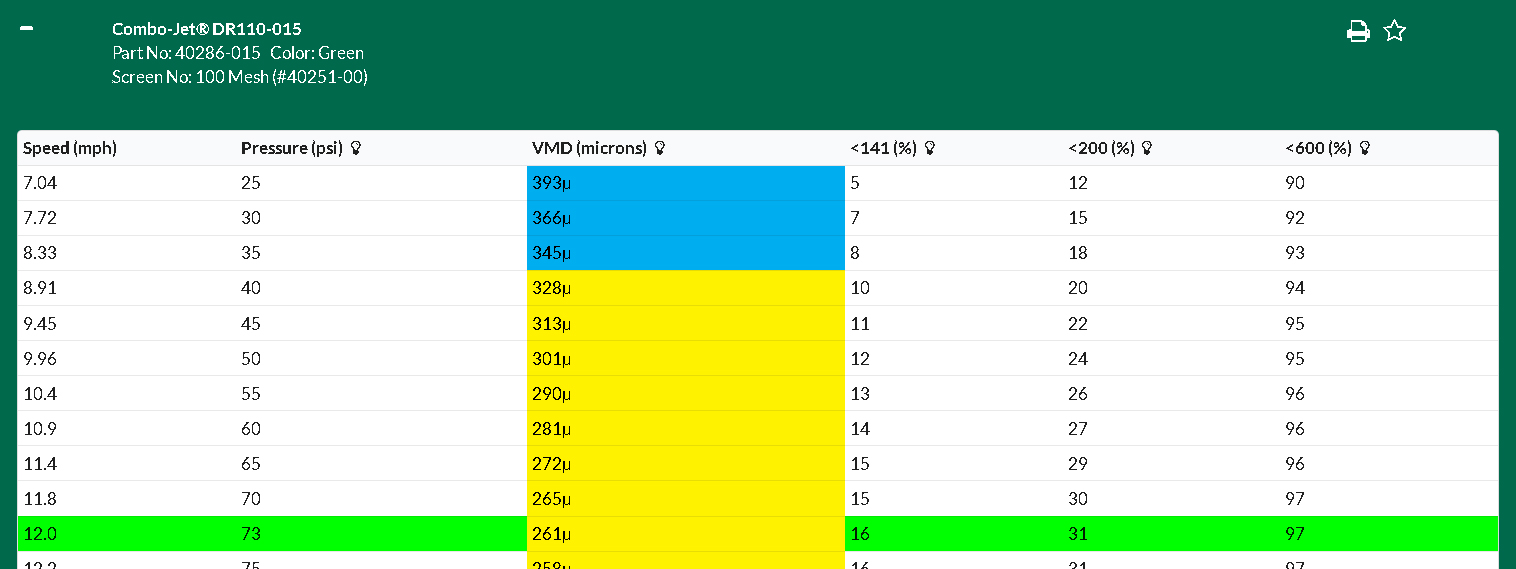
Caudal y Velocidad de Aplicación: Para mantener el caudal de aplicación (5 US GPA), desplazándose a un promedio de 12 MPH, la pulverizadora tendría que mantener ~73PSI (bastante alto), produciendo un tamaño medio de DVM. Tamaño de gota y Eficiencia: Con un DVM (o Dv0.5) de 261µ, cerca del 16% del flujo está compuesto de finos derivables (%<141µ), y 97% de gotas que pueden considerarse efectivas (%<600µ). En términos generales, los finos de deriva son relativamente altos para una aplicación de herbicida sistémico, especialmente ante factores ambientales (e.j. cultivos, lagos, etc.) que deben tenerse en cuenta. All in all: Since we are starting out at a very high pressure with quite fine spray, we will opt to go to a larger flow rate (to improve speed/pressure range), as well as check both the DR and MR series to better match the targeted droplet size to match the application better.
MR110-02 Review:
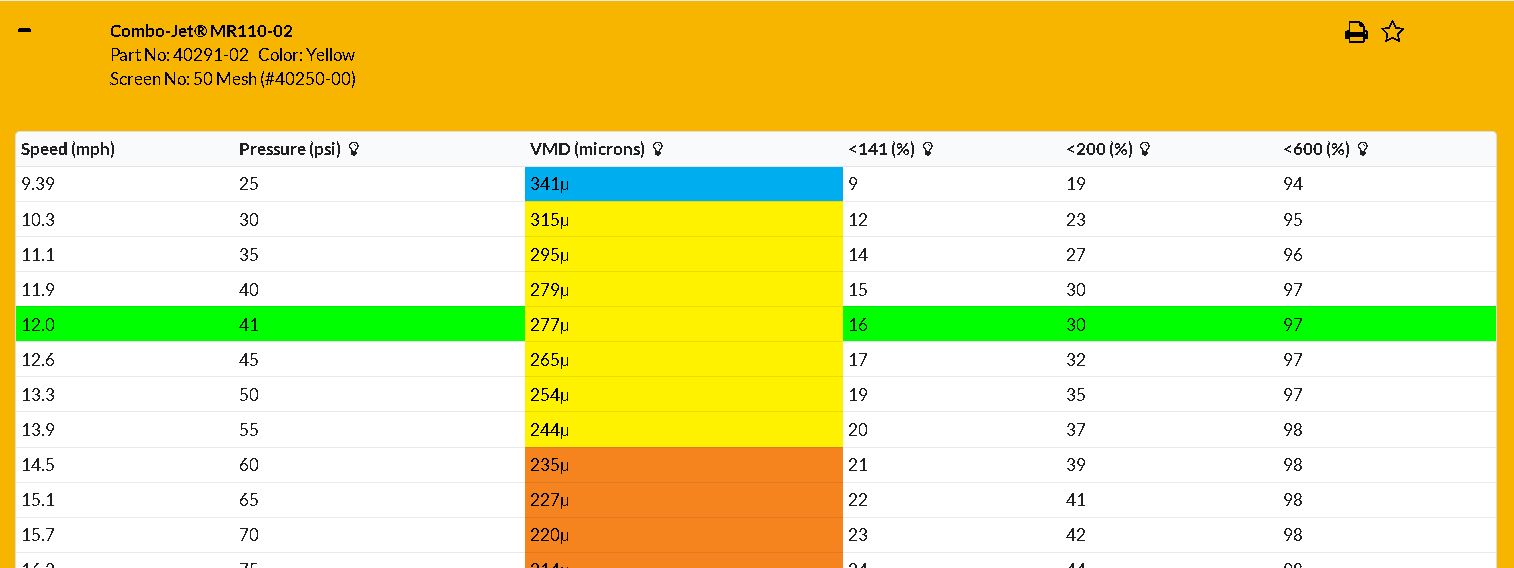
Application Rate & Speed: To maintain the application rate (5 US GPA), traveling an average 12 MPH, the sprayer would have to be maintaining ~41PSI (no issues), producing a medium droplet size VMD of ~277µ. Droplet Size & Efficacy: With a VMD (or Dv0.5) of 27µ, about 16% of the flow is composed of driftable fines (%<141µ), and 97% of the flow is made up of droplets that can be considered effective (%<600µ). Overall, the driftable fines is fairly high for a systemic herbicide application, especially if there the environmental factors (e.g. crops, lakes, etc.) that should be considered. En Definitiva: We’ve alleviated our issue of speed/pressure with the shift to the MR110-02, but we still have equivalent driftable fines and finer droplet size than we’d like.
DR110-02 Review:
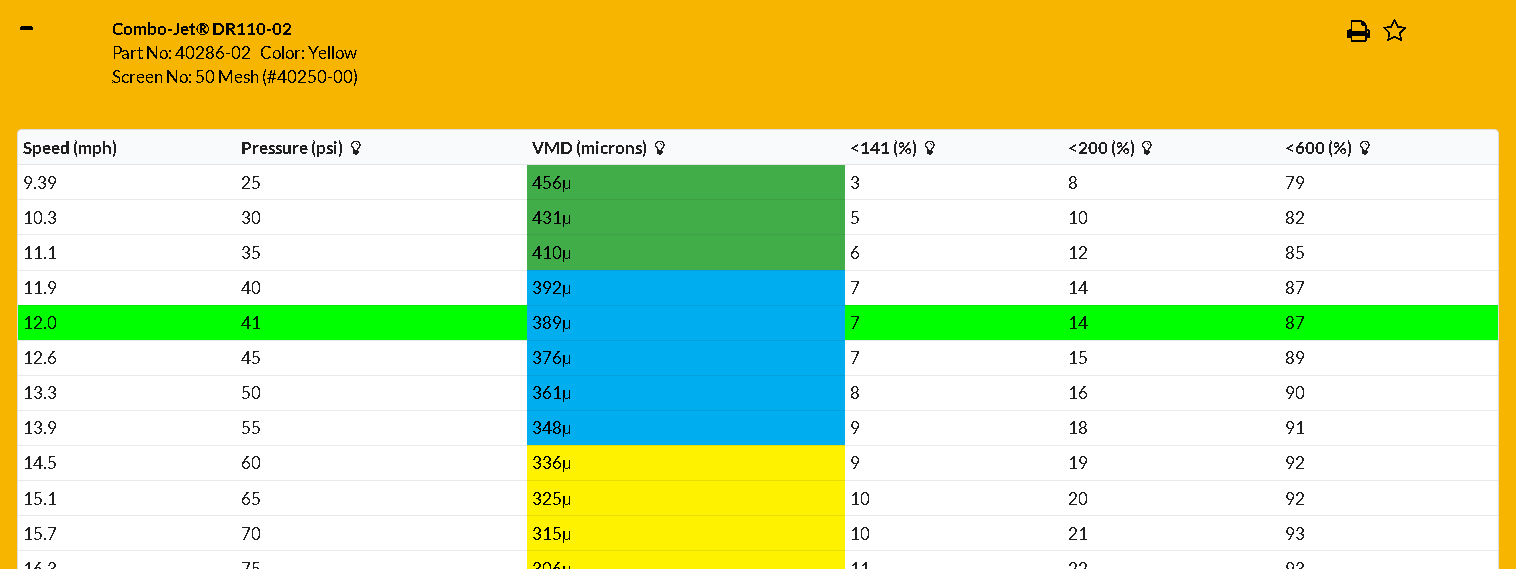
DR110-02 in a nutshell: Application Rate & Speed: To maintain the application rate (5 US GPA), traveling an average 12 MPH, the sprayer would have to be maintaining ~41PSI (no issues), producing a coarse droplet size VMD of ~389µ. Droplet Size & Efficacy: With a VMD (or Dv0.5) of 389µ, about 7% of the flow is composed of driftable fines (%<141µ), and 87% of the flow is made up of droplets that can be considered effective (%<600µ). Overall, the driftable fines is very reasonable for a typical systemic herbicide application, and if slower speeds are used around drift sensitive areas, it will produce even less drift. All in all: SUCCESS! We’ve maintained the ideal speed/pressure with the -02 size, and have alleviated the excessive drift with the ‘DR’ series (shifting from the MR series). Notice, the % of effective droplets went down from 97% to 87%, as we have shifted the spectrum of droplets sprayed to be coarser; however, given the application specification, it is recommended by chemical label that coarse spray is used to maximize efficacy & maintain reasonable drift. (remember: there is always a balance between drift and coverage for each application, some fields and areas will require further drift reduction to maintain reasonable drift given the environmental factors.) EXTRA STEP: To make sure we are not better off with a larger flow rate tip, we can check the next option (or two) within Tip Wizard’s results. This would bring us to the DR110-025.
DR110-025 Review:
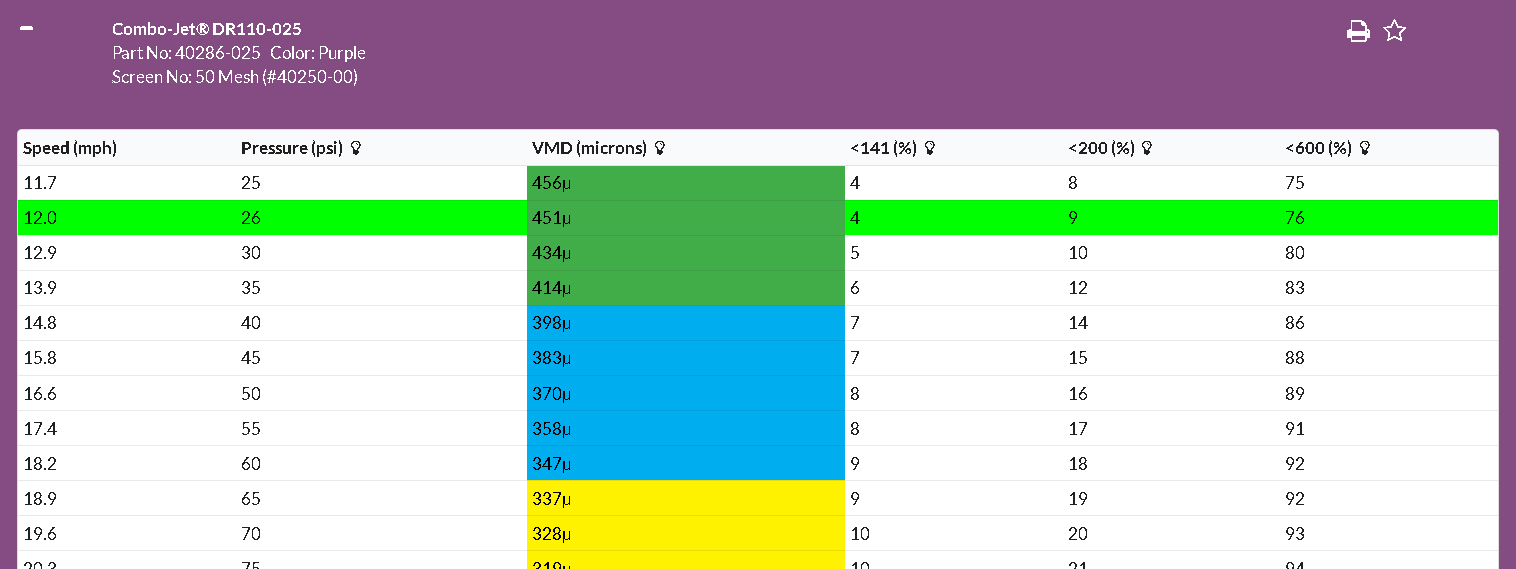
Application Rate & Speed: To maintain the application rate (5 US GPA), traveling an average 12 MPH, the sprayer would have to be maintaining ~26PSI (Too Low). Overall, the minimum recommended pressure for a DR110-025 is ~30 PSI, so this tip would not have any room to slow down. If speed is increased to maintain a higher pressure at the same flow rate, this could be reconsidered. Droplet Size & Efficacy: With a VMD (or Dv0.5) of 451µ, about 4% of the flow is composed of driftable fines (%<141µ), and 76% of the flow is made up of droplets that can be considered effective (%<600µ). At a VMD of 451µ, the spray is a little coarser than our ideal at 400µ. All in all: The DR110-025 is too large a spray tip for our operating speed/pressures, and would match our targeted droplet size/coverage at higher pressures, which would mean the sprayer would have to travel faster. (~13-18MPH, or 30-60PSI) If typical speed ranges were increased to 13-18 MPH, the DR110-025 would likely become the ideal tip choice for this example.
Switching from size tip to another
As a last note, it should be clear that if your flow rate cannot maintain your travel speed/pressure, going to the next (or last) size of spray tip may be necessary; HOWEVER, it is not always best to keep the same series of spray tip. Lets say, you have to travel faster, so you want to shift from an DR110-03 to a -04 size tip to give a better speed range. If you want the same spray quality (coarse spray vs. coarse spray), you are more likely to go from from a DR110-03 to an MR110-04, than to a DR110-04 (as the DR110-04 produces more of a very coarse spray quality).
For applications with Pulse Width Modulation (PWM) sprayers, the capability and options for spray tips multiplies, so for a more advanced spray tip selection can take place, to further increase the flexibility and ability of the spray tips to do their job: If you’d like to use Tip Wizard to follow the example, enter the below application rate/input:
For a pulse width modulation (PWM) sprayer, the capability and flexibility of spray tips increases. This means for a more advanced tip selection that can provide even greater flexibility and ability to have a successful spray application in a whole host of field conditions. If you’d like to use Tip Wizard to follow the example, enter the below application rate/input: Example Application: Systemic Herbicide for a Burn-Off Application. We would be targeting (based on chemical label) a coarse spray, or around a VMD of 400µ. (e.g. Glyphosate)

Tip Wizard shows the following results: DR110-025, MR110-03, DR110-03, MR110-04, DR110-04[…]
DR110-025 Review:

Application Rate & Speed: To maintain an application rate (5 US GPA) and match our targeted droplet size, we would be selecting ~40PSI on our PWM controller, producing the coarse spray (~400µ) we were targeting. In Tip Wizard, you will see, pressure, speed range and DC% (duty cycle). For the -025 tip size, the effective duty cycle is over 100% at our max speed of 15MPH. This means, if we travel faster than 14.8 MPH at 40PSi, we will be underapplying the application rate, as the tip size is too small. We will have to either slow down, or proceed to a larger flow rate tip, or raise our pressure to be consistently over ~45-50PSI at typical travel speeds. Droplet Size & Efficacy: With a VMD (or Dv0.5) of 401µ, about 6% of the flow is composed of driftable fines (%<141µ), and 86% of the flow is made up of droplets that can be considered effective (%<600µ). Overall, for spray efficacy as well as minimize driftable fines, this pressure/droplet size combination would be fine. (aside from the speed range issue from above) All in all: The spray tip is too small to give maximum flexibility. We cannot achieve our max speed without adjusting our pressure on our PWM system. Best we check the next size of spray tip (-03).
MR110-03 Review:

Flexible Range of Duty Cycle & Pressure: An easy way to make a functional ‘flexibility factor’ to select a spray tip is to see where operational duty cycles (e.g. 50-100%) lie across the pressure range of a spray tip. (Assuming 35PSI is the minimum spray pressure, and 60 PSI is a soft maximum) So, the goal would be to have your highest duty cycle (but still below 100%) at the lowest pressure possible for a spray tip. In this example, the -03 has a 93% duty cycle at 35 PSI, which happens to be the minimum pressure. GREAT! At the top end of the pressure range at 60PSI (~60 PSI is generally recommended as a max. pressure, as exceeding that can cause greater wear of seals within the PWM solenoids), thhe duty cycle is 71%. GREAT! So, with the ideal pressure/duty cycle range, we will then fine the series of spray tip that provides the closest matching droplet size(s) to our chemical label to maintain peak efficacy. Application Rate & Speed: Since speed & rate is effectively maintained and modulated by the PWM system, there is a huge speed range for different applications. So, application speed is more variable without the spray application changing, as long as the system is within the recommended 50-100% duty cycle range. Droplet Size & Efficacy: With the VMD of 399, the MR110-03 has ~6% of the flow composed of driftable fines (%<141) and 86% of the total flow composed of effective droplets (%<600). That is only if the speed is within the 100% duty cycle, which it isn’t. So, we would have the option to slow down to apply the targeted VMD, but we wouldn’t have a ‘drift reduction mode’ at all, and could only produce finer spray/coverage with raising the pressure. All in all: The MR110-03 has a good flow rate to keep duty cycle at ideal levels, but the droplets produced are too fine to be ideal over the flexible pressure range. With reduction in speed, we can make due with the MR110-03, but we best look to the DR110-03 for a coarser spray within the same flow rate.
DR110-03 Review:

Flexible Range of Duty Cycle & Pressure: We’ve maintained the same flexibility range for duty/cycle pressure, so no issues here. In this example, the -03 has a 93% duty cycle at 35 PSI, which happens to be the minimum pressure. GREAT! At the top end of the pressure range at 60PSI (~60 PSI is generally recommended as a max. pressure, as exceeding that can cause greater wear of seals within the PWM solenoids), thhe duty cycle is 71%. GREAT! Application Rate & Speed: Same as the MR110-03, so no issues here. Droplet Size & Efficacy: With the VMD of 396, the DR110-03 has ~6% of the flow composed of driftable fines (%<141) and 86% of the total flow composed of effective droplets (%<600). The ideal droplet size is achieved at ~60PSI, which is great. It allows for a huge versatility in creating a ‘drift reduction mode’ by reducing the pressure without changing speed. If we used 40PSI as our ‘drift reduction mode’, we can reduce driftable fines to within ~5% (down ~25% from 60PSI) while traveling the same speed. All in all: The DR110-03 has a good flow rate to keep duty cycle at ideal levels, and the droplet size is ideal at 60PSI, which makes it a very versatile spray tip. EXTRA: Just to make sure we don’t miss out on a different option that might be better for us than the DR110-03, we can check the next result (or two) of Tip Wizard.
MR110-04 Review:

Flexible Range of Duty Cycle & Pressure:With the -04 size of tip, our ability to go faster increases, but given our maximum speed of 15 MPH, it does not help our flexibility in duty cycle and pressure. If we maintain 15MPH or go slower, our duty cycle with suffer. If duty cycles progress lower than ~40%, a risk of checkerboarding (squares of poor coverage) can develop, so the change in duty cycle at the lowest speed typically traveled should be observed and pressure may need to be adjusted during slower travel speeds. Application Rate & Speed: Greater ability to go faster to put down the same rate, but much less flexible for traveling slower. Droplet Size & Efficacy: With the VMD of 404µ @ 35PSI, the MR110-04 has ~5% of the flow composed of driftable fines (%<141) and 86% of the total flow composed of effective droplets (%<600). The ideal droplet size is achieved at ~35PSI, which is quite low. It does not allow for any versatility in creating a ‘drift reduction mode’ by reducing the pressure without changing speed. There is a lot of versatility in creating finer coverage or finer spray, but that could come at the cost of increasing driftable fines. All in all: The MR110-04 has too high of a flow rate for our application. If we were traveling faster with a chemical application requiring a medium-coarse spray with less drift sensitivity, this would be a great tip choice.
Switching from size tip to another
As a last note, it should be clear that if your flow rate cannot maintain your travel speed/pressure, going to the next (or last) size of spray tip may be necessary; HOWEVER, it is not always best to keep the same series of spray tip. Lets say, you have to travel faster, so you want to shift from an DR110-03 to a -04 size tip to give a better speed range. If you want the same spray quality (coarse spray vs. coarse spray), you are more likely to go from from a DR110-03 to an MR110-04, than to a DR110-04 (as the DR110-04 produces more of a very coarse spray quality).





